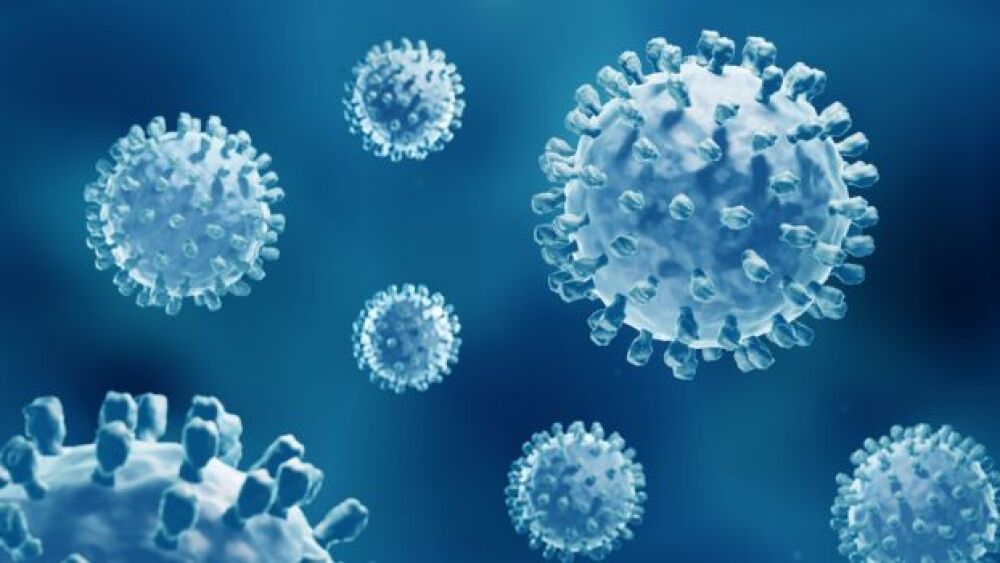A “Swiss army knife” protein that is active against several viruses may also offer some protection against Nipah virus, a lethal pathogen with no cure or vaccine.
A “Swiss army knife” protein that is active against several viruses may also offer some protection against Nipah virus, a lethal pathogen with no cure or vaccine.
The “tool” is griffithsin, a compound extracted from the red algae Griffithsia. A modified version of the protein substantially increased survival rates when administered as a preventative in a live laboratory model of Nipah virus infection.
![A “Swiss army knife” protein that is active against several viruses may also offer some protection against Nipah virus, a lethal pathogen with no cure or vaccine. The “tool” is griffithsin, a compound extracted from the red algae Griffithsia. A modified version of the protein substantially increased survival rates when administered as a preventative in a live laboratory model of Nipah virus infection. The findings, published in the Journal of Infectious Diseases, come from tests conducted at the Centers for Disease Control and Prevention, the National Cancer Institute at Frederick, the Frederick National Laboratory, and Yale University School of Medicine. “Griffithsin is promising in that it could possibly be a prophylactic treatment, and it’s an additional weapon we can add to an arsenal to target Nipah virus,” said Michael Lo, Ph.D., the study’s lead author and a microbiologist in the CDC’s Viral Special Pathogens Branch. Griffithsin is known to inhibit certain viruses, including HIV and SARS-CoV-1, in animal models. Nipah virus is one of the latest additions to the lineup, says study author Barry O’Keefe, Ph.D., director of the Molecular Targets Program and chief of the Natural Products Branch at the National Cancer Institute. Nipah virus is carried primarily by Pteropodidae fruit bats but can be transmitted to other mammals, including humans. It has afflicted hundreds of people since it emerged in 1998, causing severe respiratory disease and significant damage to the central nervous system. On average, only about a quarter of patients survive the infection, and many are left with permanent neurological defects. The study team tested two modified forms of griffithsin against the virus in a group of Syrian golden hamsters, a robust model of human infection. One form called Q-GRFT protected the hamsters from the virus and produced a survival rate of 35 percent after only a handful of doses administered through their noses. According to Lo, that’s relevant for the first live test of a potential Nipah virus prophylactic. The baseline survival rate in this type of study is zero percent. In addition, O’Keefe points out that the griffithsins used weren’t optimized to target the virus, so it may be possible to engineer a griffithsin that’s more effective and develop a better dose schedule. “[This] was the first step in preclinical development of the drug as a potential therapeutic for this virus. … Intranasal administration of griffithsin as antiviral prophylaxis is an exciting prospect,” adds study author Lauren Haugh Krumpe, a research associate in the Basic Science Program at the Frederick National Laboratory who works with O’Keefe’s group. The team confirmed griffithsin’s protective ability in cell cultures, where multiple versions, including Q-GRFT and an engineered variant called 3mG, prevented Nipah virus from entering cells—even in the face of large quantities of virus—by attaching to certain proteins on the surface of the virions. “Griffithsin targets or blocks Nipah virus in a way that’s unique. We know about antibodies, but griffithsin acts a little bit differently,” Lo said. “Our experiments definitely complemented each other” The protein’s unique antiviral effect on Nipah was first observed at the CDC and confirmed by studies at NCI at Frederick, Frederick National Laboratory, and Yale. Lo and his colleagues at the CDC conducted the live laboratory model studies and multiple tests at the cellular level. The team at Yale used pseudoviruses to confirm that griffithsin could prevent Nipah from entering host cells. O’Keefe and Krumpe at NCI at Frederick and the Frederick National Laboratory investigated griffithsin’s antiviral effects on Nipah virus proteins at the molecular level. “Our experiments definitely complemented each other to better understand the activity of griffithsin against Nipah,” Lo said. The partnership capitalized on each group’s specialty. Lo has been studying Nipah virus for more than a decade and works in a maximum biosafety level laboratory—a requirement for studying the live virus. The Yale laboratory has extensive experience with modified viruses and vaccine research. And the joint NCI at Frederick and Frederick National Laboratory team are experts in structural and chemical biology, griffithsin, and other drugs derived from the natural world. In fact, these specialties are what spawned the study. Lo attended one of O’Keefe’s presentations on griffithsin at a 2014 conference in North Carolina. When O’Keefe displayed a diagram of the protein’s structure, Lo realized it might “fit” a corresponding structure on Nipah virions and thereby hinder infection. He approached O’Keefe later in the conference about exploring its antiviral potential. “He was very open and was very excited about testing this compound, and we just started the collaboration from there,” Lo said. Lo, O’Keefe, and Krumpe plan to continue to study griffithsin’s antiviral activity in hopes of identifying more applications for use in treatments that protect humans against emerging infectious diseases. “There are numerous viruses that we find every year. … Some of those viruses can affect humans, not very efficiently currently, but that can change,” O’Keefe said, indicating that viruses like Nipah could become more infectious. “It’s important to be prepared ahead of time rather than wait until they’re here and not have something available.” By Samuel Lopez, staff writer; image modified from original by the National Institute of Allergy and Infectious Diseases, reproduced here under the CC BY 2.0 license](https://frederick.cancer.gov/sites/default/files/Nipah%20virus_NIAID.jpg)
Image modified from original by the National Institute of Allergy and Infectious Diseases, reproduced here under the CC BY 2.0 license
The findings, published in the Journal of Infectious Diseases, come from tests conducted at the Centers for Disease Control and Prevention, the National Cancer Institute at Frederick, the Frederick National Laboratory, and Yale University School of Medicine.
“Griffithsin is promising in that it could possibly be a prophylactic treatment, and it’s an additional weapon we can add to an arsenal to target Nipah virus,” said Michael Lo, Ph.D., the study’s lead author and a microbiologist in the CDC’s Viral Special Pathogens Branch.
Griffithsin is known to inhibit certain viruses, including HIV and SARS-CoV-1, in animal models. Nipah virus is one of the latest additions to the lineup, says study author Barry O’Keefe, Ph.D., director of the Molecular Targets Program and chief of the Natural Products Branch at the National Cancer Institute.
Nipah virus is carried primarily by Pteropodidae fruit bats but can be transmitted to other mammals, including humans. It has afflicted hundreds of people since it emerged in 1998, causing severe respiratory disease and significant damage to the central nervous system. On average, only about a quarter of patients survive the infection, and many are left with permanent neurological defects.
The study team tested two modified forms of griffithsin against the virus in a group of Syrian golden hamsters, a robust model of human infection. One form called Q-GRFT protected the hamsters from the virus and produced a survival rate of 35 percent after only a handful of doses administered through their noses.
According to Lo, that’s relevant for the first live test of a potential Nipah virus prophylactic. The baseline survival rate in this type of study is zero percent. In addition, O’Keefe points out that the griffithsins used weren’t optimized to target the virus, so it may be possible to engineer a griffithsin that’s more effective and develop a better dose schedule.
“[This] was the first step in preclinical development of the drug as a potential therapeutic for this virus. … Intranasal administration of griffithsin as antiviral prophylaxis is an exciting prospect,” adds study author Lauren Haugh Krumpe, a research associate in the Basic Science Program at the Frederick National Laboratory who works with O’Keefe’s group.
The team confirmed griffithsin’s protective ability in cell cultures, where multiple versions, including Q-GRFT and an engineered variant called 3mG, prevented Nipah virus from entering cells—even in the face of large quantities of virus—by attaching to certain proteins on the surface of the virions.
“Griffithsin targets or blocks Nipah virus in a way that’s unique. We know about antibodies, but griffithsin acts a little bit differently,” Lo said.
“Our experiments definitely complemented each other”
The protein’s unique antiviral effect on Nipah was first observed at the CDC and confirmed by studies at NCI at Frederick, Frederick National Laboratory, and Yale.
Lo and his colleagues at the CDC conducted the live laboratory model studies and multiple tests at the cellular level. The team at Yale used pseudoviruses to confirm that griffithsin could prevent Nipah from entering host cells. O’Keefe and Krumpe at NCI at Frederick and the Frederick National Laboratory investigated griffithsin’s antiviral effects on Nipah virus proteins at the molecular level.
“Our experiments definitely complemented each other to better understand the activity of griffithsin against Nipah,” Lo said.
The partnership capitalized on each group’s specialty. Lo has been studying Nipah virus for more than a decade and works in a maximum biosafety level laboratory—a requirement for studying the live virus. The Yale laboratory has extensive experience with modified viruses and vaccine research. And the joint NCI at Frederick and Frederick National Laboratory team are experts in structural and chemical biology, griffithsin, and other drugs derived from the natural world.
In fact, these specialties are what spawned the study. Lo attended one of O’Keefe’s presentations on griffithsin at a 2014 conference in North Carolina. When O’Keefe displayed a diagram of the protein’s structure, Lo realized it might “fit” a corresponding structure on Nipah virions and thereby hinder infection. He approached O’Keefe later in the conference about exploring its antiviral potential.
“He was very open and was very excited about testing this compound, and we just started the collaboration from there,” Lo said.
Lo, O’Keefe, and Krumpe plan to continue to study griffithsin’s antiviral activity in hopes of identifying more applications for use in treatments that protect humans against emerging infectious diseases.
“There are numerous viruses that we find every year. … Some of those viruses can affect humans, not very efficiently currently, but that can change,” O’Keefe said, indicating that viruses like Nipah could become more infectious. “It’s important to be prepared ahead of time rather than wait until they’re here and not have something available.”




